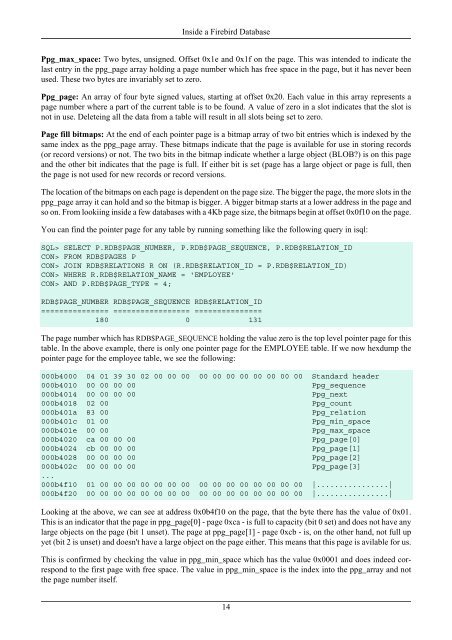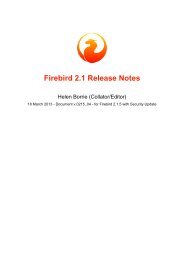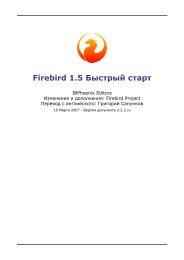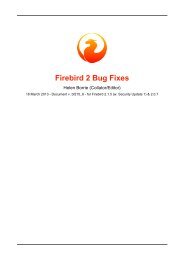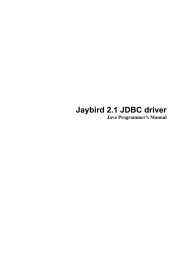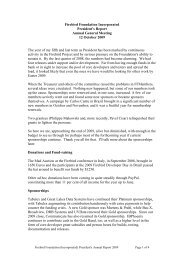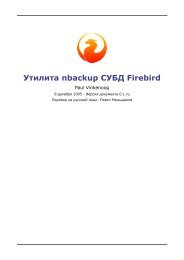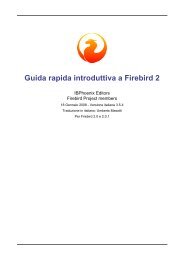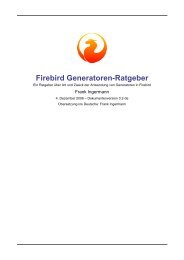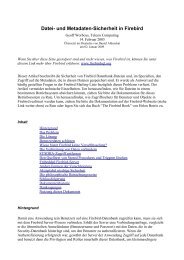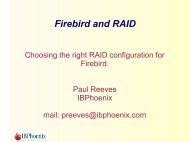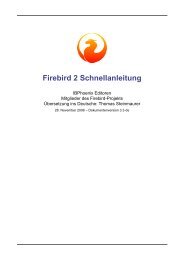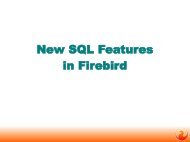Page Inventory Page - Type 0x02 - Firebird
Page Inventory Page - Type 0x02 - Firebird
Page Inventory Page - Type 0x02 - Firebird
Create successful ePaper yourself
Turn your PDF publications into a flip-book with our unique Google optimized e-Paper software.
Inside a <strong>Firebird</strong> Database<br />
Ppg_max_space: Two bytes, unsigned. Offset 0x1e and 0x1f on the page. This was intended to indicate the<br />
last entry in the ppg_page array holding a page number which has free space in the page, but it has never been<br />
used. These two bytes are invariably set to zero.<br />
Ppg_page: An array of four byte signed values, starting at offset 0x20. Each value in this array represents a<br />
page number where a part of the current table is to be found. A value of zero in a slot indicates that the slot is<br />
not in use. Deleteing all the data from a table will result in all slots being set to zero.<br />
<strong>Page</strong> fill bitmaps: At the end of each pointer page is a bitmap array of two bit entries which is indexed by the<br />
same index as the ppg_page array. These bitmaps indicate that the page is available for use in storing records<br />
(or record versions) or not. The two bits in the bitmap indicate whether a large object (BLOB?) is on this page<br />
and the other bit indicates that the page is full. If either bit is set (page has a large object or page is full, then<br />
the page is not used for new records or record versions.<br />
The location of the bitmaps on each page is dependent on the page size. The bigger the page, the more slots in the<br />
ppg_page array it can hold and so the bitmap is bigger. A bigger bitmap starts at a lower address in the page and<br />
so on. From lookiing inside a few databases with a 4Kb page size, the bitmaps begin at offset 0x0f10 on the page.<br />
You can find the pointer page for any table by running something like the following query in isql:<br />
SQL> SELECT P.RDB$PAGE_NUMBER, P.RDB$PAGE_SEQUENCE, P.RDB$RELATION_ID<br />
CON> FROM RDB$PAGES P<br />
CON> JOIN RDB$RELATIONS R ON (R.RDB$RELATION_ID = P.RDB$RELATION_ID)<br />
CON> WHERE R.RDB$RELATION_NAME = 'EMPLOYEE'<br />
CON> AND P.RDB$PAGE_TYPE = 4;<br />
RDB$PAGE_NUMBER RDB$PAGE_SEQUENCE RDB$RELATION_ID<br />
=============== ================= ===============<br />
180 0 131<br />
The page number which has RDB$PAGE_SEQUENCE holding the value zero is the top level pointer page for this<br />
table. In the above example, there is only one pointer page for the EMPLOYEE table. If we now hexdump the<br />
pointer page for the employee table, we see the following:<br />
000b4000 04 01 39 30 02 00 00 00 00 00 00 00 00 00 00 00 Standard header<br />
000b4010 00 00 00 00 Ppg_sequence<br />
000b4014 00 00 00 00 Ppg_next<br />
000b4018 02 00 Ppg_count<br />
000b401a 83 00 Ppg_relation<br />
000b401c 01 00 Ppg_min_space<br />
000b401e 00 00 Ppg_max_space<br />
000b4020 ca 00 00 00 Ppg_page[0]<br />
000b4024 cb 00 00 00 Ppg_page[1]<br />
000b4028 00 00 00 00 Ppg_page[2]<br />
000b402c 00 00 00 00 Ppg_page[3]<br />
...<br />
000b4f10 01 00 00 00 00 00 00 00 00 00 00 00 00 00 00 00 |................|<br />
000b4f20 00 00 00 00 00 00 00 00 00 00 00 00 00 00 00 00 |................|<br />
Looking at the above, we can see at address 0x0b4f10 on the page, that the byte there has the value of 0x01.<br />
This is an indicator that the page in ppg_page[0] - page 0xca - is full to capacity (bit 0 set) and does not have any<br />
large objects on the page (bit 1 unset). The page at ppg_page[1] - page 0xcb - is, on the other hand, not full up<br />
yet (bit 2 is unset) and doesn't have a large object on the page either. This means that this page is avilable for us.<br />
This is confirmed by checking the value in ppg_min_space which has the value 0x0001 and does indeed correspond<br />
to the first page with free space. The value in ppg_min_space is the index into the ppg_array and not<br />
the page number itself.<br />
14


